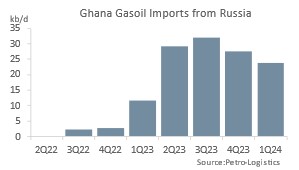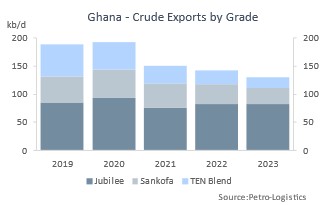Another New West African Refinery: Ghana's Sentuo
Read in 3 minutes
All eyes in the market have been on the giant Dangote refinery but there is another new refinery in West Africa which has attracted much less attention: the Chinese-built Sentuo refinery in Ghana. The facility started operations in January 2024 and will have a final capacity of close to 120 kb/d. According to the Ghanaian ministry of energy, the refinery was running at 30 kb/d in March 2024.
According to the IEA, Ghanaian product demand in 2021 averaged around 82 kb/d. When launching the new refinery in January 2024, the Ghanaian president acknowledged that the country relied on imports for 97% of its products. Those product imports have historically come from a wide variety of suppliers in the Atlantic Basin and Middle East.

This narrowed in early 2023 when European countries imposed a ban on imports of Russian petroleum products. By the end of 2023, Ghana had received an average of 25 kb/d of gasoil from Russia.

Ghana has been forced to rely on the import market to cover its petroleum product demand due to the poor reliability of its (until recently) only refinery. The Tema Oil Refinery has historically processed nearby West African barrels, predominantly Nigerian grades, which it was originally designed to run since the country was not producing any crude.
Since the start of domestic production though, it has been stated by engineers working at the refinery that it is not able to process Ghanaian Jubilee crude despite the grade being very similar to other regional grades. Rather than a technical constraint of the refinery, it may instead be a government decision to prioritise Jubilee for the export market. Arrivals of crude for the Tema Oil Refinery from countries covered by Petro-Logistics have been very sporadic in the last five years, indicating that Tema remains a barely-operating plant.
Seen as a rival for the underfunded Tema refinery, the Sentuo refinery was built as part of China’s Belt and Road Development strategy and is owned by the Chinese Sentuo company. With an initial capacity of 40 kb/d, the refinery’s second phase will take it to a total capacity of 120 kb/d. The refinery is designed to run medium to heavy crude oil. Sentuo, contrary to Tema, is able to process Ghanaian crudes and has apparently negotiated a partial baseload supply of domestic grades from the government.
Ghana started to produce crude in 2010, with Tullow developing the Jubilee field. The country’s two other export grades are TEN Blend and Sankofa. Ghanaian crude production averaged roughly 130 kb/d in 2023, according to the minister of energy. This matches Petro-Logistics’ data very closely, which also shows 130 kb/d in 2023 versus 142 kb/d in 2022. Ghanaian crude exports peaked in 2020, at 193 kb/d.

With field operators pushing to raise production, combined with some imported crude from Russia, total Ghanaian exports have remained fairly stable despite the start of the new 40 kb/d (future 120 kb/d) Sentuo refinery. To compensate declines at some of the fields, it is hoped that new production will be enough to keep crude exports stable. At the same time, Sentuo and maybe one day the restored Tema refinery will hopefully prove able to supply the domestic market with the products it needs.


